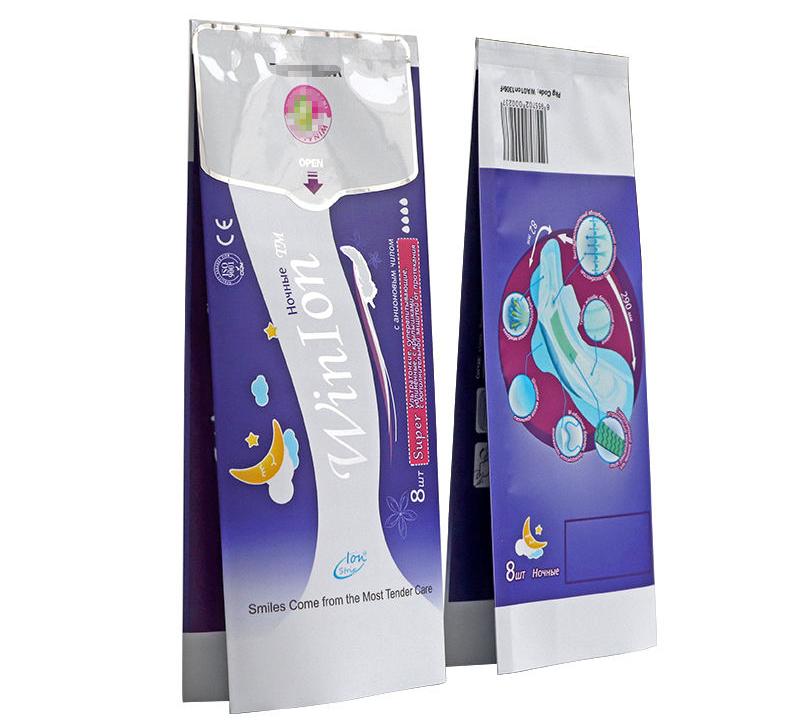Features of Sanitary Napkins Packaging Bags
2024-06-05
Sanitary napkins packaging bags are specialized bags designed to store and protect sanitary napkins during transportation, storage, and retail display. These bags are essential for maintaining the hygiene, integrity, and freshness of the sanitary napkins until they are ready for use. Here's an overview of sanitary napkins packaging bags, including their features, materials, design considerations, and environmental impact:
Features of Sanitary Napkins Packaging Bags
1. Hygiene Protection: Prevents contamination and exposure to external elements, ensuring sanitary napkins remain clean and hygienic.
2. Moisture Resistance: Provides a barrier against moisture to prevent dampness and maintain the integrity of the sanitary napkins.
3. Odor Control: Helps contain odors associated with sanitary napkins, ensuring discretion and freshness.
4. Tear Resistance: Durable construction to prevent tears or punctures during handling and transportation.
5. Easy Opening and Closure: Convenient opening and closure mechanisms for easy access to the sanitary napkins while maintaining product freshness.
6. Visual Appeal: Attractive design and branding to enhance product visibility and appeal on retail shelves.
Materials Used in Sanitary Napkins Packaging Bags
1. Plastic Films:
- Polyethylene (PE): Offers flexibility, moisture resistance, and cost-effectiveness.
- Polypropylene (PP): Provides higher stiffness and strength compared to PE, suitable for heavier packaging requirements.
- Biodegradable Films: Environmentally friendly alternatives made from biodegradable polymers.
2. Laminates:
- PET/PE Laminates: Combines the strength of polyester (PET) with the flexibility of polyethylene (PE), providing excellent barrier properties.
- Metalized Films: Aluminum or metalized coatings enhance barrier properties against moisture, oxygen, and light.
3. Bioplastics:
- PLA (Polylactic Acid): Biodegradable and derived from renewable resources such as corn starch or sugarcane.
- PHA (Polyhydroxyalkanoates): Biodegradable polymers produced by microbial fermentation of renewable feedstocks.
Design Considerations for Sanitary Napkins Packaging Bags
1. Size and Shape: Customized to accommodate different sizes and shapes of sanitary napkins, ensuring a snug fit and efficient use of space.
2. Sealing Method: Options include heat sealing, zipper closures, resealable adhesive strips, or tear-away perforations for easy opening.
3. Graphics and Branding: Incorporate branding elements, product information, and visually appealing designs to attract consumers' attention.
4. Sustainability: Consider eco-friendly materials and packaging designs to minimize environmental impact and appeal to environmentally conscious consumers.
5. Regulatory Compliance: Ensure compliance with relevant regulations and standards governing packaging materials and hygiene products.
Environmental Impact and Sustainability
1. Material Selection: Choose eco-friendly materials such as biodegradable films, recyclable plastics, or bioplastics to reduce environmental impact.
2. Recyclability: Design packaging that is recyclable and compatible with existing recycling infrastructure to promote circularity and reduce waste.
3. Biodegradability: Opt for biodegradable materials that break down naturally in the environment, reducing pollution and landfill burden.
4. Reduced Packaging: Explore packaging designs that minimize material usage and waste while maintaining product protection and integrity.
Conclusion
Sanitary napkins packaging bags play a crucial role in ensuring the hygiene, freshness, and appeal of sanitary napkins for consumers. By incorporating features such as moisture resistance, tear resistance, and attractive design, while also considering sustainability and environmental impact, manufacturers can create packaging solutions that meet the needs of consumers while minimizing their ecological footprint.



